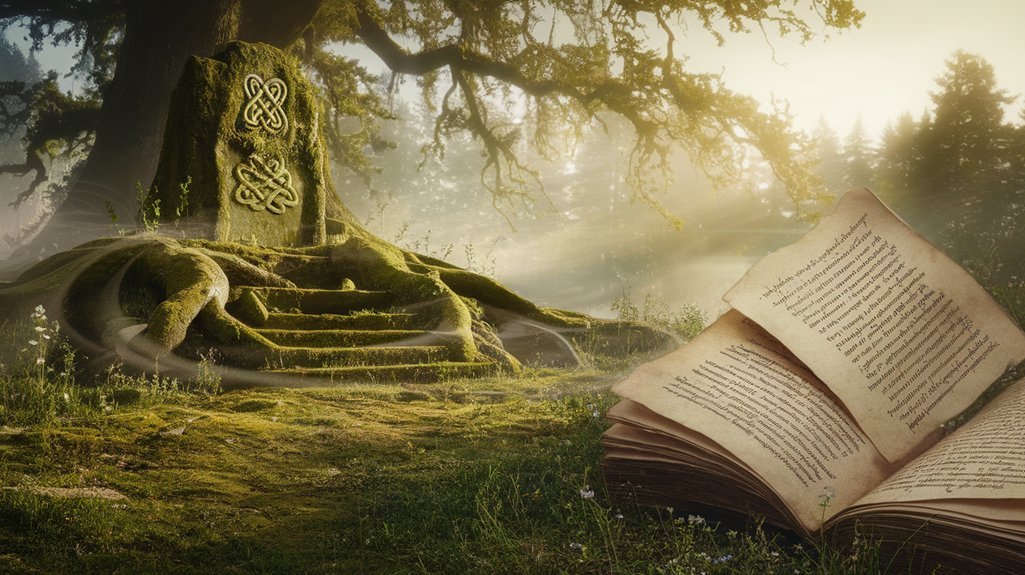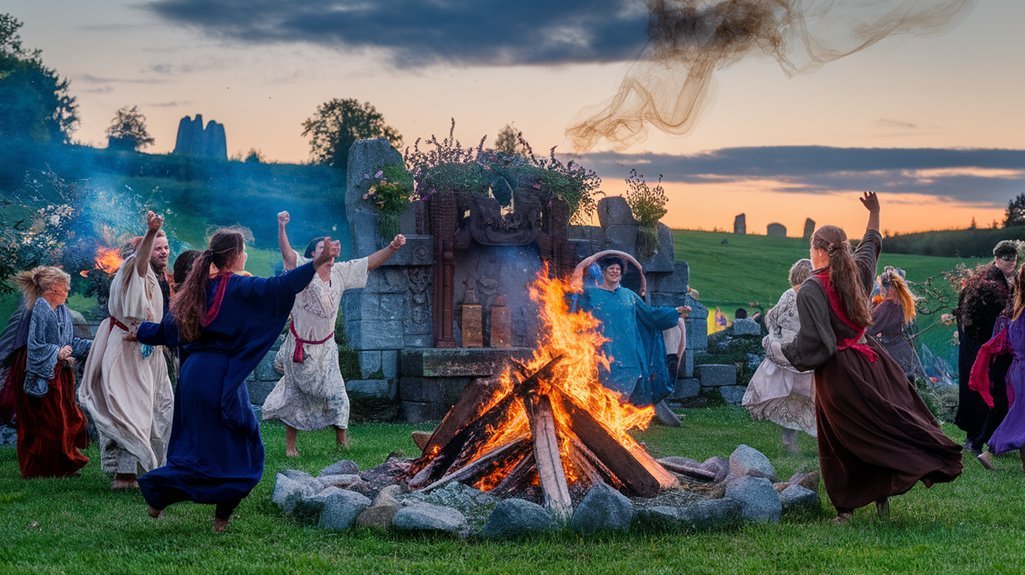As an Amazon Associate I earn from qualifying purchases.
Embark on a journey, explore ancient rituals, and uncover the essence of Celtic Paganism. You'll find that the Druids, with their profound wisdom, played a central role in this rich cultural tapestry. As you decode ancient Celtic texts, you'll gain insights into the deep connection these practices have with nature's rhythms. The allure of these timeless traditions continues to captivate, inviting you to discover how they persist in today's world.
Key Takeaways
- Celtic rituals are deeply interwoven with the cycles of the year, reflecting agricultural calendar milestones.
- Druids preserved sacred knowledge and guided communities through oral traditions and spiritual leadership.
- Sacred sites like Newgrange and Tara reveal insights into ancient Celtic ceremonial practices.
- Modern adaptations of Celtic spirituality integrate traditional symbols with contemporary elements, ensuring historical accuracy.
- Celtic spirituality fosters a profound connection to nature, emphasizing harmony and respectful coexistence.
The Origins of Celtic Paganism

Though often shrouded in mystery, the origins of Celtic Paganism can be traced to the ancient peoples who inhabited Western Europe, particularly in regions such as Ireland, Scotland, and Wales. You'll discover that these early Celts developed a rich tapestry of beliefs and practices rooted in their natural surroundings and daily lives. Central to Celtic mythology were ancient deities, each embodying facets of the environment and human experience.
Goddesses like Brigid, revered for her association with poetry and healing, and gods such as Lugh, celebrated for his skills and craftsmanship, formed the backbone of a pantheon that guided spiritual life. As you delve into these origins, you'll understand how interconnectedness with nature and reverence for these deities influenced daily rituals and seasonal celebrations. This spiritual framework provided the Celts with a profound sense of identity and continuity, weaving their cultural narrative through time.
The Role of the Druids in Celtic Society
While exploring Celtic society, you'll find that the Druids played an indispensable role in maintaining the cultural and spiritual fabric of the community. They were the keepers of sacred knowledge, acquired through rigorous Druidic education. This education equipped them with the wisdom to offer spiritual guidance, drawing upon oral traditions passed down through generations.
Druids held significant community roles, serving not only as spiritual leaders but also as mediators and advisors. Their deep nature reverence informed their ethical teachings, emphasizing harmony with the natural world. As ceremony leaders, they orchestrated rituals that connected the community with the divine, ensuring the continuity of spiritual practices.
Their influence extended beyond religion, impacting legal and educational aspects of society. Through their teachings and leadership, the Druids fostered a cohesive community grounded in shared values and cultural heritage. In essence, the Druids were the heart of Celtic societal life, embodying its spiritual and intellectual core.
Decoding Ancient Celtic Texts

When you explore ancient Celtic texts, you'll find that interpreting symbols and translating Druidic manuscripts require both linguistic skill and cultural understanding. It's important to recognize that these texts often employ complex symbolism reflective of Celtic spiritual beliefs and societal values. By approaching these manuscripts with respect and scholarly care, you can uncover insights into the rituals and cultural practices of the Celtic peoples.
Interpreting Celtic Symbols
Understanding the intricate web of Celtic symbols requires both a keen eye and a respect for the rich tapestry of ancient traditions they represent. As you delve into Celtic iconography, you'll find a world imbued with symbolic meanings that reach far beyond their visual appeal. Each symbol, whether it's the spiraling triskelion or the interwoven knots, tells a story rooted in the beliefs and values of the Celtic people. Deciphering these symbols isn't merely an exercise in artistic appreciation; it's a journey into the minds of ancient societies. By recognizing the cultural and historical contexts in which these symbols were used, you gain insight into how the Celts viewed the world, nature, and the divine forces that they believed governed their lives.
Translating Druidic Manuscripts
Exploring Celtic symbols naturally leads to the fascinating endeavor of translating Druidic manuscripts, where the symbols' meanings come to life through the written word. You'll find that manuscript preservation is crucial in maintaining the integrity of these ancient texts. The process involves carefully handling fragile documents, often written on materials like vellum or parchment, which have survived centuries.
Understanding linguistic evolution is key. The Celtic languages have transformed over time, impacting how you interpret these manuscripts. The shift from Old Irish to Middle Irish, for instance, demands a keen eye for subtle linguistic nuances. By studying these changes, you gain insight into the cultural and historical context of the Druids. Translating these texts allows you to connect with the ancient wisdom embedded within their pages.
Archaeological Insights Into Celtic Rituals
As you explore the archaeological findings related to Celtic rituals, you'll discover sacred sites that offer a glimpse into the spiritual practices of the past. These sites, often marked by distinctive structures and landscapes, provide valuable context for understanding the ceremonial life of the Celts. By analyzing ritual artifacts unearthed at these locations, you can gain a deeper appreciation for the symbolic meanings and cultural significance they held.
Sacred Sites Uncovered
When you delve into the archaeological discoveries of Celtic sacred sites, you uncover a wealth of insights into their intricate rituals and spiritual practices. These sites, often nestled within sacred landscapes, reveal a tapestry of ancient pilgrimage routes and ceremonial spaces. The Celts viewed natural features—rivers, groves, and hills—as imbued with divine significance, transforming them into focal points for worship. By examining these locations, you gain an understanding of how they integrated their environment into spirituality. Excavations at sites like Tara and Newgrange show evidence of gatherings that marked seasonal cycles, suggesting a deep connection to nature's rhythms. As you explore these findings, you're invited to appreciate the Celts' profound relationship with the land, echoing their enduring legacy in modern spiritual practices.
Ritual Artifacts Analysis
The examination of ritual artifacts offers a tangible connection to the spiritual world of the Celts. By analyzing these items, you unlock insights into their complex belief systems and rituals. Archaeologists have unearthed a variety of ritual tools and ceremonial objects, each with unique functions and meanings, reflecting the Celts' reverence for nature and the divine. These artifacts include:
- Bronze cauldrons, used in feasts and sacrifices to honor deities.
- Stone altars, serving as sacred spaces for offerings.
- Decorated torcs, symbolizing status and spiritual authority.
Understanding these objects requires a careful balance of historical accuracy and cultural sensitivity, allowing you to appreciate the Celts' spiritual practices. This knowledge deepens your grasp of how ritual tools were integral to their sacred ceremonies.
The Influence of Nature and Seasons

Understanding the influence of nature and seasons is crucial to grasping the essence of Celtic Pagan rituals. These rituals are deeply interwoven with the cycles of the year, reflecting reverence for nature spirits and the changing seasons. Each Celtic festival, or seasonal celebration, marks a key point in the agricultural calendar, linking human life to the rhythms of the earth.
For instance, the festival of Samhain honors the end of the harvest and the beginning of winter, a time when the veil between worlds is thinnest.
| Season | Celebration |
|---|---|
| Spring | Beltane |
| Summer | Lughnasadh |
| Autumn | Samhain |
These celebrations do more than mark time; they express a profound connection with the natural world. By participating in them, you embrace an ancient worldview where nature's cycles dictate not only physical sustenance but also spiritual guidance, reminding you of your place within the cosmos.
Modern Adaptations of Celtic Practices
While ancient Celtic rituals have largely evolved, many people today still find ways to incorporate these traditions into contemporary life. You can witness this transformation in the form of Celtic fusion, where ancient symbols and practices blend with modern beliefs. In Neo Pagan practices, you'll find a rich tapestry of old and new, as practitioners honor the past while embracing the present.
In your exploration of these adaptations, consider:
- Personal Altars: Craft spaces that merge traditional Celtic symbols with modern elements.
- Seasonal Celebrations: Observe solstices and equinoxes with updated rituals that respect ancient seasonal markers.
- Meditative Practices: Engage in meditation or visualization, drawing inspiration from Celtic myth and lore.
These modern adaptations reflect a deep respect for historical accuracy and cultural sensitivity, allowing you to appreciate the timeless wisdom of Celtic traditions while making them relevant to today's world. By doing so, you participate in a living tradition, bridging past and present.
The Revival of Celtic Festivals

As you delve into the revival of Celtic festivals, you'll discover how these ancient celebrations are experiencing a renaissance in today's world. Across Europe, North America, and beyond, people are gathering to honor Celtic traditions through vibrant festival celebrations. These events are not just reenactments but are infused with historical reverence and cultural appreciation.
| Festival | Key Elements |
|---|---|
| Samhain | Ancestral remembrance, bonfires |
| Imbolc | Brigid's blessings, purification |
| Beltane | Fire rituals, fertility dances |
| Lughnasadh | Harvest feast, games |
| Winter Solstice | Yule logs, storytelling |
The rekindling of these festivals reflects a deep-seated desire to connect with the past. Participants engage in age-old rituals, fostering a sense of community and continuity. By attending these celebrations, you become part of a living tradition, where ancient practices meet modern interpretations, ensuring that the essence of Celtic spirituality remains vibrant and relevant.
The Enduring Appeal of Celtic Spirituality
Celtic spirituality captivates many due to its rich tapestry of myth and nature-centric beliefs, offering a profound connection to both the earth and the cycles of life. This appeal lies in its integration of Celtic mythology with spiritual practices that resonate across generations. You'll find that Celtic traditions emphasize a harmonious existence with nature, revering sacred landscapes and seasonal changes.
- Celtic mythology: Stories of gods and goddesses illustrate timeless archetypes and moral lessons.
- Spiritual practices: Rituals like solstice celebrations and ancestor veneration create a sense of continuity and belonging.
- Connection to nature: Beliefs encourage respectful coexistence with the natural world, fostering environmental awareness.
Frequently Asked Questions
What Are the Main Deities Worshipped in Celtic Paganism?
You'll find that Celtic deities like Dagda, Brigid, and Lugh hold significant places in worship. They embody divine attributes such as wisdom, healing, and craftsmanship, reflecting the rich cultural tapestry of Celtic spiritual beliefs.
How Does Celtic Paganism Differ From Other Forms of Paganism?
Imagine stepping into an ancient world where Celtic cosmology shapes your beliefs. You'll find Celtic paganism uniquely intertwines ritual significance with nature. Unlike other forms, it emphasizes harmony with natural cycles, reflecting a distinct cultural identity and spiritual depth.
Are There Specific Symbols Associated With Celtic Rituals?
You'll find specific Celtic symbols like the triskele or the Celtic knot intricately tied to ritual meanings. These symbols convey themes of life cycles, spirituality, and interconnectedness, reflecting the historical depth and cultural sensitivity of Celtic rituals.
How Do Celtic Pagan Practices Influence Modern Witchcraft?
Did you know 60% of modern witches incorporate Celtic folklore into their practices? Celtic ritual practices, rich in symbolism and seasonal celebrations, shape contemporary witchcraft by emphasizing nature's cycles and ancient wisdom, fostering a deeper spiritual connection.
What Is the Significance of Celtic Sacred Sites Today?
You explore Celtic sacred sites today to connect with ancient energies and landscapes. These sites, significant for their sacred geography, draw spiritual tourism, offering a deeper cultural appreciation and understanding of historical and spiritual practices.
Conclusion
As you delve into the world of Celtic Paganism, you'll find it's like stepping into an ancient forest, where every leaf whispers stories of harmony with nature. This journey through time reveals how these timeless rituals and ethical teachings continue to resonate today. By embracing these practices with historical accuracy and cultural sensitivity, you're helping to keep their vibrant legacy alive, ensuring that the spirit of the Celts dances through the ages like the eternal dance of the seasons.
Amazon and the Amazon logo are trademarks of Amazon.com, Inc, or its affiliates.


